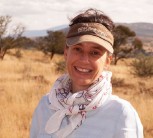Nine new trapdoor spider species have been discovered in the Great Karoo by researchers at the University of Pretoria’s (UP) Department of Zoology and Entomology, and the Agricultural Research Council (ARC). This brings the count of members of the Stasimopus genus, which is endemic to Southern Africa, to 56 distinct species.
News about the discoveries was announced in the journal Zootaxa.
“A distinguishing feature of trapdoor spiders is the way in which they cover their underground burrows with a trapdoor-like lid made of soil, silk and plants,” explains lead author Dr Shannon Brandt, a recent PhD graduate from UP. “These burrows can be up to 30 centimetres deep. Depending on the species, some burrows are wide enough for a R5 coin to fit in, while a smallish orange could easily be dropped into others.”
Once sexually mature, males leave their burrows to mate. Females and immature males generally remain within the burrows, from which they pounce within a millisecond on passing prey such as grasshoppers, beetles and even small frogs, and inject them with venom (which is not harmful to humans).
The exemplars used to describe the new species were collected across the Great Karoo during 2018 and 2019. Fieldworkers focused on drainage lines, as these are favoured by trapdoor spiders. Survey work took place at 79 sites on farms in the Northern Cape, Western Cape and the Eastern Cape, around towns such as Beaufort West, Richmond, Murraysburg, Jansenville and Willowmore. All the samples are being kept in the National Collection of Arachnida at the ARC in Pretoria.
Thanks to subsequent genetic and taxonomic work by Dr Brandt, the tally of trapdoor spider species known to be found in the Great Karoo is now 23 species. Experts believe it is possible to find more new species in the arid region.
The survey work was supported through the Karoo BioGap project, which was led by the South African National Biodiversity Institute in the late 2010s and funded through the National Research Foundation. It saw researchers from a host of South African research institutes, including UP, pool their efforts to survey and research the plants and animals of the Great Karoo region. The aim was to better understand the interconnected ecosystems and sensitive habitats of this notoriously under-surveyed arid region. The endeavour has not only led to the description of various new species of trapdoor spiders, but of scorpions, aloes and freshwater fish new to science too.
“Through projects like the Karoo BioGap Project, we are able to truly start understanding South African biodiversity,” says Robin Lyle of the ARC, who led spider research during the project. “It’s important to know as much about the region’s biodiversity as possible, given the potential that shale gas fracking, mining, farming and general land-use changes could have on the environment. This foundation biodiversity data could eventually help to understand the impact of climate change within the region.”
In recognition of the impetus that Karoo BioGap gave to the study of spiders, the researchers involved in the Zootaxa paper named one of the new species Stasimopus Karooensis, specimens of which they collected in the Eastern Cape part of the Karoo, around the towns of Jansenville and Pearson.
Another new species was named Stasimopus venterstadensis – The only known specimens of the species were collected in 2018 near Venterstad in sandy soil among buffalo grass and Karoo shrubs.
A male sample of Stasimopus ignis was serendipitously collected from under a doormat at Toonbothasfontein, a farm near Richmond, where the survey team slept during one of their collection trips. A female specimen was found near Hanover, also in the Northern Cape.
“‘Ignis’ refers to the Latin word for fire or flame,” Dr Brandt explains. “The word alludes to the increased frequency of fire in the Nama Karoo. Such events were historically rare, but are likely increasing because of climate change. It also refers to the fact that the female’s body is much redder than that of most other species.”
Dr Brandt’s interest in trapdoor spiders began during her time as an honours student at UP. She received a PhD degree in Zoology at UP in 2023, and has since taken up a postdoctoral position in Bordeaux in France at INREA, a public research institution that focuses on agriculture, food and the environment. She has published four papers on the trapdoor spiders of the Great Karoo, including one in Evolutionary Biology, in which she sets out guidelines on how to use the relative size and position (called the average ocular pattern) of trapdoor spiders’ eyes to distinguish between Karoo species.
She named Stasimopus dylani after her husband, Dylan, in recognition of his support and encouragement during the course of her postgraduate studies. The species was collected in sandy soils around Murraysburg, Jansenville and Willowmore, and is thought to be widespread across the Western Cape and Eastern Cape parts of the Karoo.
Stasimopus theaei is named after Lyle’s eight-year-old daughter, Thea, while Stasimopus finni was named after Finn Pirk, the three-year-old son of co-author Professor Catherine Sole of UP’s Department of Zoology and Entomology. Prof Sole, who was also Dr Brandt’s PhD supervisor, says her son loves “all creepy crawlies”. Examples of both species were first collected around Somerset East, in an area dominated by low shrubs and aloes.
Click on the video in the sidebar to watch a trapdoor spider catch its prey, or read the infographic to learn some facts on spiders or click on the gallery to see how they burrow under their trapdoors.
Dr Shannon Brandt and Prof Catherine Sole
April 8, 2024

Dr Shannon Brandt began doing research at the University of Pretoria (UP) during her honours year in 2017. She received a PhD in 2023.
“I have been doing research at UP for seven years,” she says, “but the three years as an undergraduate student makes it 10 years of academic endeavours at UP.”
Dr Brandt chose to study at UP because of the incredible reputation of the Department of Zoology and Entomology.
“All the researchers there are phenomenal, and they create a great environment for developing independent skills as a researcher.”
As to how her research contributes to the betterment of the world, she says her research at UP in taxonomy, phylogenetics and evolutionary biology is foundational to all other biological research.
“It is vital to understand both the actual number and distribution of species as well as how they got to where they are through evolutionary time. This knowledge allows us to make the best decisions when it comes to conserving the precious biodiversity we have.
“We cannot understand how a taxon got to the present without considering their evolutionary past, and we cannot predict where they will end up if we do not consider their adaptive potential. Both of these facets are paramount if we want to effectively conserve life on our planet.”
Dr Brandt’s current research aims to decipher the role that epigenetic mechanisms play in helping populations of organisms to adapt to local conditions both in their lifetime and trans-generationally.
“This is very important when it comes to long-lived tree species as they cannot ‘migrate’ to better environmental conditions. We want to understand how we can use the tools of selective breeding, assisted migration and possibly genetic engineering to aid these species in adapting to the pressures of climate change.”
Dr Brandt participates in the EpiTree project, which involves multiple French organisations studying the role of epigenetic marks (such as DNA methylation) in the phenotypic plasticity of poplar and oak trees. Her role is to understand population epigenetics within oak trees.
A major highlight in her research career was being published in the journal Zootaxa.
“It was a really nice experience to describe so many interesting new species. Another milestone was getting my PhD and an interesting postdoctoral position in a completely new field in a new place to explore.”
During her postgraduate studies, Dr Brandt says she was privileged to have two incredible supervisors, Professor Catherine Sole and Dr Robin Lyle.
“They are truly inspiring role models for women in science, technology, engineering and mathematics in particular. They produce amazing research while being great teachers and nurturing the talents of their students. They inspired me by demonstrating that you can have it all – you can be a scientist, have a family life, be a great mentor and anything else you want to be.”
In terms of what she hopes to achieve in her research endeavour, Dr Brandt says her main ambition is twofold: “To continually learn and grow by accepting new challenges and never remaining in a comfort zone. The second is to grow the scientific community and add to the knowledge pool. I want to be part of understanding the genetic and evolutionary foundations of species to aid in the conservation of life on our planet.”
She regards curiosity and persistence as the most important qualities in a researcher. Her advice to school learners or undergraduates who are interested in doing research is to find something they are interested in, even if it is not the most charismatic subject matter.
“Ask as many questions as you can, then pursue the answers passionately and persistently. The most mundane things are interesting if you find a different way to look at them and ask the right questions.”
Her hobbies include running, crocheting, drawing and wandering around new places as often as she can.

Professor Catherine Sole's research is driven by the power of molecular techniques in testing evolutionary processes at various levels: population, species and higher taxa with special focus on invertebrates. She aims to find common evolutionary patterns in different taxa that reflect landscape and phylogenetic changes; and linking them to climatic, biogeographic and geological changes.
She is affiliated with the University of Pretoria Forestry and Agricultural Biotechnology Institute (FABI) to which she contributes entomological capacity and expertise.
 Story
Story
University of Pretoria (UP) researchers have found that the antioxidant content of certain types of tea can be likened to that found in recommended portions of fruit and vegetables.
 Infographic
Infographic
Half a cup of black tea, oolong tea or green tea contained the same amount of antioxidants with radical scavenging capabilities (RSC) as that of a 200mg vitamin C tablet.
 Story
Story
Researchers at the University of Pretoria (UP) may have identified the gene that is responsible for diet-related obesity. By exploring the role of the novel gene Slc7a8, they have made a potential breakthrough in current knowledge about the cellular mechanisms that drive fat accumulation. This understanding is crucial in developing effective treatments.
Copyright © University of Pretoria 2025. All rights reserved.
Get Social With Us
Download the UP Mobile App